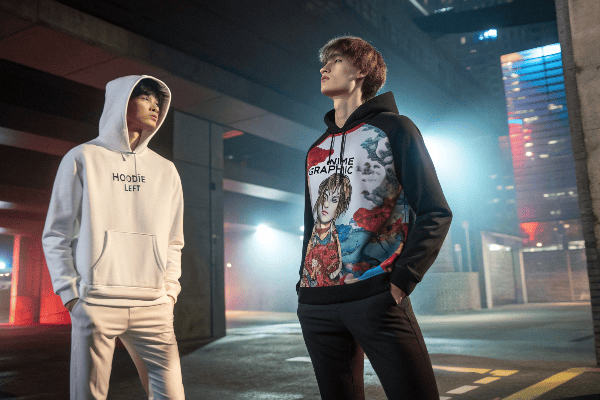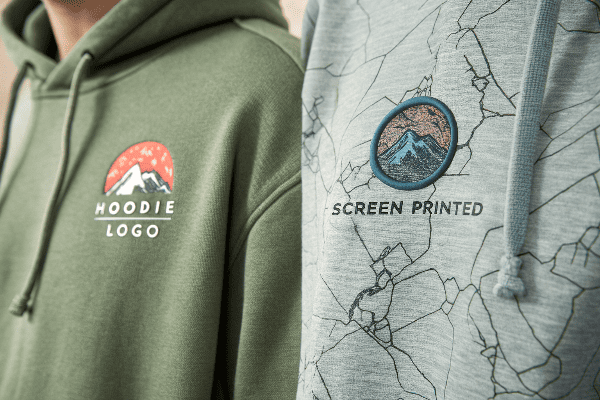Streetwear hoodies1 are more than just clothes; they’re a statement. Whether for a personal brand or a retail business, choosing the right decoration method can make or break your product’s appeal.
Embroidery and screen printing are the two most common methods for branding hoodies. Embroidery offers durability and a premium look, while screen printing provides vibrant designs and cost efficiency. The best choice depends on your brand’s needs, aesthetic goals, and budget.

Many factors influence this decision, from durability to cost-effectiveness. Let’s break it down so you can make an informed choice.
What Are the Main Differences Between Embroidery and Screen Printing?
Streetwear demands high-quality, eye-catching designs. The decoration method plays a key role in achieving that.
Embroidery stitches the design directly onto the fabric, giving a raised, textured feel. Screen printing uses ink to create a smooth, graphic-like finish. Each method has its strengths and weaknesses.

Visual and Textural Differences
| Feature | Embroidery | Screen Printing |
|---|---|---|
| Appearance | 3D, raised texture | Flat, smooth print |
| Durability | Very durable, long-lasting | Can fade/crack over time |
| Color Options | Limited thread colors | Wide range of ink colors |
| Best for | Logos, small detailed designs | Large, vibrant graphics |
Embroidery gives a premium, professional touch, but it may not work well for large designs. Screen printing allows vibrant, detailed graphics but can wear out faster. The choice depends on the style you want.
Which One Lasts Longer on Hoodies?
Hoodies are meant for everyday wear. The last thing you want is a design that fades after a few washes.
Embroidery lasts longer because the thread is woven into the fabric, making it resistant to fading. Screen printing can crack or peel over time, especially with frequent washing.

Wash and Wear Resistance
Embroidery withstands heavy washing1, making it great for long-term wear. Screen printing, while vibrant at first, can fade faster. Here’s a comparison:
| Factor | Embroidery | Screen Printing |
|---|---|---|
| Washing Effect | Maintains shape and color | Fades or cracks over time |
| Longevity | Lasts years with proper care | Shorter lifespan, especially with frequent washing |
| Best for | Hoodies meant for everyday wear | Promotional or fashion-forward designs |
If longevity is a top priority, embroidery is the better option.
Which One Is More Cost-Effective for Bulk Orders?
Streetwear brands need cost efficiency. Large orders can mean big savings—or unexpected costs.
Screen printing is more cost-effective for bulk orders because the setup cost is spread across many pieces. Embroidery is pricier due to labor and thread costs, especially for large designs.

Pricing Breakdown
| Factor | Embroidery | Screen Printing |
|---|---|---|
| Setup Cost | Higher due to thread work | Lower per unit on large orders |
| Cost Per Unit | More expensive | Cheaper, especially for large orders |
| Scalability | Harder to scale due to manual labor | Easy to scale for mass production |
For businesses selling high quantities, screen printing is usually the better financial choice.
Which One Looks Better for Streetwear?
Aesthetics are everything in streetwear. Your design needs to stand out.
Embroidery gives a high-end, textured look, often associated with luxury. Screen printing allows bold, colorful graphics that appeal to modern streetwear styles.

Choosing the Right Look
| Factor | Embroidery | Screen Printing |
|---|---|---|
| Streetwear Appeal | Luxury, professional | Bold, artistic |
| Best for | Minimalist branding, premium hoodies | Large, colorful designs |
| Customization | Limited to stitching styles | Highly flexible with colors and effects |
If your brand is about high-end quality, embroidery is the way to go. If you want bold, trend-driven designs, screen printing is better.
Conclusion
Both embroidery and screen printing have their place in streetwear. Embroidery is durable and premium, while screen printing offers flexibility and affordability. The right choice depends on your brand’s vision, target audience, and budget.


